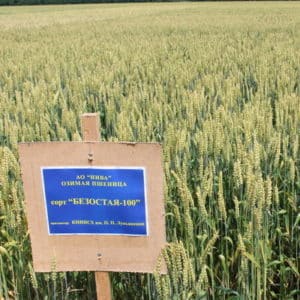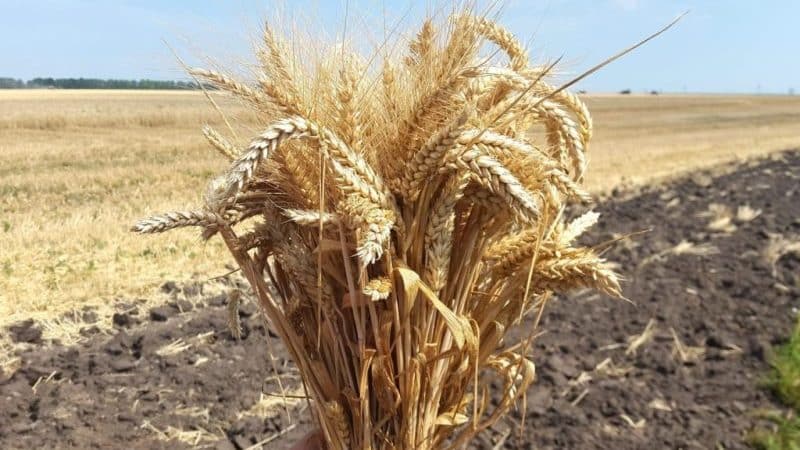Winter wheat variety Bezostaya 100: characteristics and description
The huge potential of new breeding varieties of grain allows even beginning farmers to receive super profits. One of the crops offered by scientists from leading research institutes is Bezostaya 100. This winter wheat demonstrates high yields in the fields and resistance to diseases in unfavorable years.
What kind of wheat is this?
Many agronomists call winter Bezostaya 100 an improved version of the well-known variety Bezostaya 1.
Material with unique varietal characteristics was obtained by Kuban specialists at the National Grain Center named after P. P. Lukyanenko. The variety was included in the State Register of the Russian Federation in 2014.
Botanical description
Pedigree of the variety: Lutescens 3415k8-6-4 x Lutescens 198-93k80. Variety - Lutescens.
The plant forms compact upright bushes 81–104 cm high. The root system is fibrous, branched in the soil layer. The primary root system consists of 3–6 roots.
Characteristics
Wheat Bezostaya 100 is a mid-early, medium-growing variety that is resistant to lodging. Its signs:
- semi-erect bush;
- the leaves are light green, covered with a waxy coating of low intensity, and not pubescent at the time of tillering;
- the spike has a regular cylindrical shape, medium density and length, the spinous processes in the upper third reach 5–15 mm;
- spikelet scales are ovoid-elongated, 9-10 mm long, 3.5–4.4 mm wide, with intensely expressed nervation;
- glume tooth moderately curved, straight;
- actively expressed keel, shoulder wide, vertically raised;
- colored grain;
- the grain is medium-sized, elongated-ovate, red, bare at the base, shallow groove.
Properties
Winter wheat Bezostaya 100 is a mid-early variety with a growing season of ripening of 221–296 days. The crop is classified as high quality baking grain, food group A.
Protein content is from 15%, gluten - from 27%.
Recommended growing regions
The highest yields are shown in the Central Black Earth, North Caucasus and Lower Volga regions.
Reference! According to the State Variety Commission, a record harvest of Bezostaya 100 wheat was obtained in 2016 in the Stavropol Territory. The indicators were 100.7 c/ha.
Features of cultivation
The originator guarantees that the wheat soft winter Bezostaya 100 has an advantage when sowing on eared and row-crop predecessors, including corn for grain.
Reacts well to placement on beets, legumes, clover, buckwheat, early and mid-season potatoes. It is not recommended to plant it after barley due to the risk of root rot.
Optimal soil density, structure and aeration:
- good phytosanitary condition;
- the presence of a breast up to 8 cm in diameter;
- high-quality leveled surface;
- leveled pre-sowing layer with a volumetric mass of 1.1–1.3 g/cm;
- soil particles with a diameter of 1–3 mm;
- The difference in the height of the ridges is no more than 2 cm.
Provided the seed bed is leveled and there is a sufficient level of humidity, Bezostaya 100 manages to take root in the shortest possible time with minimal losses of seed material and produces 4-5 million seedlings per 1 hectare of field.
Sowing technology
The technology for sowing selective winter wheat includes:
- Non-moldboard tillage of soil after non-fallow predecessors to a depth of 8–12 cm using units with harrows or rollers.
- Treating the material with insecticidal and fungicidal preparations simultaneously (“Maxim Forte”, “Maxim XL”, “Celestom Top”, “Lamador”)
- Planting seeds to a depth of no more than 3–5 cm with mandatory instant rolling to maintain moisture.
- Harrowing to avoid crusting.
Experienced agronomists prefer to reduce the average sowing rate of selected varieties, but not to increase the amount of mineral fertilizers to obtain a high yield. The global sowing rate for winter wheat is 125 c/ha.
Planting time varies depending on the region and current weather conditions and ranges from early August to mid-October.
Care
Caring for winter crops includes control of weeds, pests and diseases, additional fertilizing during germination and tillering.
The optimal rate of pre-sowing fertilization of the field with organic matter is 20–25 t/ha. Under main cultivation of the site, the full norm of potassium and phosphorus compounds is applied.
Nitrogen fertilizing is carried out in 2-3 doses when the plants emerge into the tube and in the heading phase using the root method. Calculation of the norm is carried out according to the manufacturer’s instructions and taking into account the general condition of the soil.
Diseases and pests
Characteristic diseases of winter grains - rust, bacteriosis, septoria, helminthosporiasis. The main signs of plant damage are slow growth, absence of ovaries, rotting of spikelets and roots.
Reference! Bezostaya 100 is resistant to powdery mildew, fusarium head blight, brown and yellow rust, and is slightly susceptible to smut.
The winter form of cultivation allows you to avoid infection by many pests and diseases due to severe frosts. When crops are damaged, the field is treated with Bayleton, Tilt, and Fundazol.
The most common crop pests include bread beetle, grain fly, and ground beetle. To combat them, high-quality pre-sowing loosening of the soil and treatment of seeds before planting are carried out. Affected plants are treated with Karate and Bazudin.
Productivity
With average ear productivity, the expected yield is 50–60 c/ha, potential - up to 100 c/ha. Weight of 1000 grains - 37–45 g.
When seeds are planted deeper than 3–5 cm, wheat sets the tillering node late and winters poorly. This error reduces the yield by an average of 20–30 c/ha.
Collection technology and timing
It is important that the harvest in one area does not stretch for more than 5–7 days. The recommended method for harvesting Bezostaya 100 wheat is direct harvesting in the waxy ripeness phase with seed moisture up to 28% for up to 7 days.
Storage
During storage maintain optimal humidity levels (up to 70%). The room is provided with constant ventilation, ventilation and cooling. The correct temperature is +5...+8°C.
Before laying, the grain is cleaned of weeds and impurities, dried and disinfected. Disinfection is carried out using wet, aerosol or gas methods, using preparations such as “Contador Maxi”, “Viking”.
The optimal storage period for winter wheat grain is 240 days, the maximum is 30 months. After the starch content in the raw material decreases, the quality suffers. The batches are systematically monitored to identify fungal diseases.
Advantages and disadvantages of the variety

The relatively young variety Bezostaya 100 has the following advantages:
- resistance to root rot;
- suitable for cultivation using the grain predecessor;
- drought and heat resistant.
The disadvantages of the variety for large farms include the relatively high cost of seed. Plants are noted to be intolerant of failure to meet grain harvest deadlines: every day of inactivity leads to activation of respiration and burning of starch, which reduces yield by 1 c/ha daily.
Advice! Breeders recommend sowing varieties of different ripeness groups on one farm in order to reduce losses during the harvest period and safely extend the harvest over 2-3 weeks.
The average cost of 1 ton of wheat seed Bezostaya 100 is 30–32 thousand rubles. (about $500) when purchased in bulk. The price is valid for 2019.
Conclusion
Winter soft wheat Bezostaya 100, with strict adherence to grain agricultural technology, allows you to collect large volumes of grain in extreme conditions. The main purpose of use - a record harvest - when growing crops is achieved with minimal costs for chemicals and fertilizers, which justifies the high cost of seed.